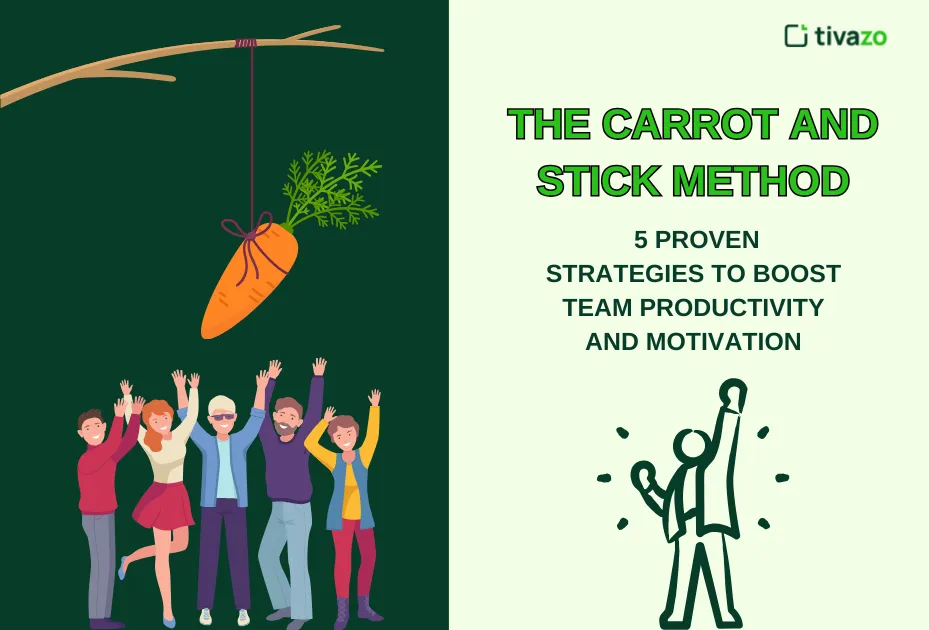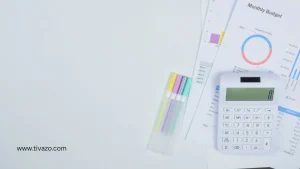Would you like a more intelligent way to motivate your team and get better results? The carrot and stick method can be the missing piece you’ve sought. The carrot and stick method has been around for a long time, and it is a proven way to use rewards (the carrot) or consequences (the stick) to influence behaviors, performance, productivity, and focus with a team.
But wait! Before you get all stressed thinking the carrot and stick is about dangling bonuses in front of employees or throwing a deadline at them, the carrot and stick concept can be effectively applied and utilized the right way to trigger better performance, avoid burnout, and promote accountability in any workplace.
In this post, there are 5 proven actions that demonstrate how to utilize the carrot and stick method in a modern, positive, and productive manner. Let’s take a look at how leaders, managers, and even individual workers can use the method to stay motivated and keep others motivated and accountable as well.
✅ What You’ll Learn in This Blog
- The true meaning and psychological aspects of the carrot and stick concept.
- Why does this concept still work for motivation with contemporary teams in 2025?
- 5 actionable strategies to increase team productivity utilizing positive reinforcement or accountability.
- Typical errors leaders make in using the carrot and stick concept – and how to avoid those mistakes.
- How to balance extrinsic recognition with empathy and sustaining employee engagement in the long run.
What Is the Carrot and Stick Method?
The carrot and stick method is a common way of motivating behaviors that includes rewards (“the carrot”) and punishment (“the stick”) to encourage behaviors. The carrot and stick method works to create behaviors through motivation by using a combination of rewards for positive behaviors and punishment for negative behaviors.
Definitions and Origins of the Carrot and Stick Approach
The phrase “carrot and stick” comes from a metaphor related to motivating a donkey; the donkey will move based on the proximity of the carrot in front of him or being poked with a stick to move forward. The carrot and stick method is similarly based upon B.F. Skinner’s operant conditioning theory describes the way behavior is conditioned as a result of reinforcement and punishment.
The Psychology Behind Reward vs. Punishment
This approach is fundamentally based on two primary driving forces:
- Positive Reinforcement (the carrot): Rewards such as bonuses or praise increase motivation through triggering dopamine
- Negative reinforcement or punishment (the stick): A negative consequence, such as reprimanding, discourages inappropriate behavior by reducing it in the future, but could upset an employee if it is overdone.
A well-balanced carrot and stick method creates clear incentives and accountability without harming morale.
Why the Carrot and Stick Method Still Matters in 2025
The carrot and stick method remains important in 2025 because it:
- Creates a clear understanding of expectations for rewards and consequences.
- Balances motivation and accountability for effective, sustainable behaviors.
- Works well for modern, diverse, and remote teams
- Allows for motivation and productivity in a time of change.
What exactly is Carrot and Stick Motivation?

Carrot and stick motivation is a traditional theory for motivation designed to entice (the “carrot”) and deter (the “stick”) action. The theory is based on the notion that individuals are motivated to perform better when there is an apparent incentive for action and consequences for opposing an action.
- The “carrot” refers to positive reinforcement — e.g., bonuses, promotions, compliments, or perks.
- The “stick” signifies negative reinforcement — e.g., added work, loss of a bonus, or negative accountability
It’s popular in management, education, sports, and even personal goal setting. If applied correctly, it can help motivate people by giving them direction, urgency, and purpose.
Why the Carrot and Stick Method Is Motivating for Teams
The carrot and stick method is motivating for teams because it considers human psychology; it uses both rewards and consequences to influence behaviors. It creates a balance to create a productive work environment with clear expectations.
How It Affects Behaviors in the Workplace
By reinforcing desirable behaviors and discouraging unproductive behaviors, the carrot and stick method provides structure. When employees are aware that their effort is rewarded, and poor performance is rectified in a timely manner, employees are more likely to stay engaged
Examples.
- Leadership: The Manager will implement the carrot and stick method by rewarding employees with bonuses based on performance and by acknowledging those who need improvement with performance reviews.
- Sports: Coaches are motivating athletes by way of game time (the carrot) or being benched (the stick).
- Business: Sales teams will get commissions when hitting targets as a carrot and lose privileges as a stick.
Intrinsic vs. Extrinsic Motivation System
The carrot and Stick method fits with extrinsic motivation of being influenced by tangible rewards; however, in the right circumstances of being deliberate with the use of praise and recognition, the carrot and stick method gets at intrinsic motivation as a way to support bettering oneself and build long-lasting commitment.
Examples of Carrot and Stick
Here are real examples that illustrate the carrot and stick method as applied in an everyday situation:
- At Work
- Carrot: Employees who meet their sales target get a quarterly bonus.
- Stick: Employees who consistently perform below expectations get enrolled in a performance improvement plan.
- In Education
- Carrot: Students with perfect attendance get some bonus points or a certificate.
- Stick: Students with excessive absences affect or lose their participation grade, and someone notifies their parents.
- On Fitness & Personal Goals
- Carrot: If you meet your fitness goals, you get a reward, such as new workout gear or a cheat day.
- Stick: If you miss workout days, you have to donate money to a charity you don’t support.
- With Team Management
- Carrot: Teams that complete a project early get to take extended long weekends or lunchtimes.
- Stick: Late delivery inhibits employee performance reviews and the overall rank of project priority.
These examples illustrate how the carrot and stick method can be modified to motivate different kinds of people in any given environment, but always with a view to improved performance and improved focus.
5 Proven Strategies for Effective Use of the Carrot and Stick Method

The carrot and stick method is more than simply rewarding people or disciplining people! It is an attempt at constructing a well-balanced motivation operation that improves performance, strengthens accountability, and fosters developmental potential over time. Below are 5 identifiable strategies to operationalize it in the workplace:
Strategy 1: Provide clear rewards for clear goals.
- Establish measurable, time-sensitive objectives that are easy to track.
- Use performance-based rewards such as bonuses, promotions, or recognition.
- Communicate precisely what the “carrot” is assigned to each task or milestone.
- Encourage and maintain team motivation through observable expressions of gratitude and reward.
- The carrot and stick method provides engagement when the reward is linked to the goal.
Why it works: The carrot and stick method relies on clarity. When goals are clear, every step and every result is measurable and earned, and performance improves naturally.
Strategy 2: Use Fair Consequences for Accountability
- Clearly define the “stick.” Everyone knows the consequences of missed deadlines or poor performance.
- Use constructive instruments of accountability, such as performance reviews and shifting responsibilities.
- Be consistent with consequences. Meaning not random or emotional.
- Focus on improvement, not punishment, to maintain trust.
- Reinforcing accountability through carrot and stick methods helps to ensure there is accountability without fear.
The carrot and stick method (for lack of a better term) creates accountability that is fair and sustainable.
Strategy 3: Finding the Balance Between Motivation and Empathy
- Expectations must be firm, but they also require emotional intelligence and support.
- When giving feedback, being direct is okay if the feedback is solutions and coaching that go along with it.
- Avoid overly punitive actions that destroy morale and long-term productivity.
- As well, recognize effort as well as recognizing results, and build a growth-oriented environment.
- The carrot and stick method is most effective when driven by empathy rather than pressure.
The carrot and stick method works best when accountability is balanced with empathy.
Strategy 4: Tailoring the strategy for the personalities on your team
- Find out what motivates each team member—ask and do not assume!
- Personalize rewards (carrots) for individuals; some may appreciate time, while others may prefer money.
- Tailor “sticks” to being corrective versus demotivating, based on the individual’s style.
- Do not have blanket policies; tailor the motivation to improve behavior and retention.
- The carrot and stick plan is effective when it is not a “catch-all” policy.
A tailored carrot-and-stick policy encourages engagement and loyalty.
Strategy 5: Regular Review, Reflection, and Adaptability
- Monitor what the motivation techniques are producing—what are the successes and failures?
- Host a regular check-in with the team to provide room for honest feedback.
- Be willing to adjust rewards or consequences as the team dynamics change.
- The carrot and stick method can benefit from the use of performance data.
- Improvement ensures you are still relevant in your motivation strategies in 2025.
Adaptive carrot-and-stick methods keep motivation fresh and relevant.
🚫The Most Common Pitfalls of the Carrot and Stick Approach
- Excessive Utilization of Punishment (The Stick)
- Excessive implementation of negative consequences will create more fear, stress, and resistance than motivation.
- Ambiguous or Unclear Outcomes
- If either the goals or the rules aren’t clearly defined will make both the rewards and the consequences feel unfair or unmotivating.
- Inconsistent Follow-Through
- If you disappoint your employees by not delivering on promised rewards or by not implementing the necessary consequences, you erode any trust they may have had, and the “carrot and stick” model will be useless.
- Not Recognizing Individual Motivational Preferences
- The “carrot” will be different for different people; employing a “one-size-fits-all” engagement model undermines your engagement efforts.
- Neglecting the Longer-Term Culture and Morale
- Using the “carrot and stick” model is useful for short-term benefits, but for an organization to remain effective and engaged, workers will need to be in an environment where they feel safe, autonomous, and trusted.
Conclusion: Motivation as a Skill, Not Just a Trick
Motivation is not a trick; it takes awareness, consistency, and balance to truly be a skill of leadership. The carrot and stick technique is most effective when there is a clear reward and consequence, but when taking into consideration empathy and respect. Applying the carrot and stick technique to each person and revisiting regularly will ensure the techniques work for you and have employees engaged authentically.
When applied reasonably, the carrot and stick technique creates a clear and productive structure that promotes performance without fostering burnout or entitlement. Rather than controlling, you are redirecting your teams toward the collective continued success of sustaining motivation. By managing your teams with a practical purpose in mind and being consistent, managers are able to release employees’ individual potential and build a motivated and high-performing workplace.
Are you ready to generate motivation and contribute to moving the insurance and risk management industry forward? Start practicing the carrot and stick technique to lead your teams to success now! Take action now!
FAQ’s
What is the meaning of the carrot and stick approach?
The carrot and stick methodology is a motivational strategy that provides a mixture of rewards ("carrot") and punishments ("stick") to establish a desired outcome from behavior and behavior avoidance.
What is carrot and stick strategy?
The carrot and stick method is a balance of positive reinforcement (rewards) and negative consequences (punishments) to affect people's behavior. The carrot and stick method is often used in management, leadership, and behavior change for influencing the behavior of individuals and teams.
What are carrot and stick mechanisms?
Carrot and stick mechanisms refer to the ways that rewards and punishments are used to motivate to achieve a behavior, for example bonuses, praise, or penalties, that are established as behavior shapes rewards.
Is the carrot and stick method effective?
Yes, when used in a fair and strategic manner, it can increase productivity, encourage accountability, and set individual goals that align with team outcomes.




